The link doesn't seem to be working for me http://www.gia.edu/pdfs/Fall_2001_Cut.pdf
You are using an out of date browser. It may not display this or other websites correctly.
You should upgrade or use an alternative browser.
You should upgrade or use an alternative browser.
Which is more important? Fire or brightness?
- Thread starter Garry H (Cut Nut)
- Start date
Yeah, the link wouldn't work for me either... but it is the correct URL! Just google "GIA fall 2001 fire," and it's right there.
It's a very good article to complement the one from AGS. Thanks, TL!
Both articles got me thinking...
1. It seems as though Tolk's choice of P40.75 C34.5 actually did NOT maximize light return for his presumed LGF and table! Given his LGF of 50-60 and very small table maximum light return would be "steep deep"--in fact, it probably hits exactly where the AVR is cut (a little over 41 pav, a little over 35 crown).
2. Why has the Tolk pav crown combination stayed so popular? There is another combination that would perform pretty similarly in overall (at least in fire, brilliance), but is much spreadier:
Pav: 38
Crown: 25
Table: 53
LGF: 78
Star: 55
I don't know if all those align exactly, but you get the point. The character would be a little different, but I'm sure there's a market for people who want a huge spread and still very good to excellent light performance (at least in theory).
It's a very good article to complement the one from AGS. Thanks, TL!
Both articles got me thinking...
1. It seems as though Tolk's choice of P40.75 C34.5 actually did NOT maximize light return for his presumed LGF and table! Given his LGF of 50-60 and very small table maximum light return would be "steep deep"--in fact, it probably hits exactly where the AVR is cut (a little over 41 pav, a little over 35 crown).
2. Why has the Tolk pav crown combination stayed so popular? There is another combination that would perform pretty similarly in overall (at least in fire, brilliance), but is much spreadier:
Pav: 38
Crown: 25
Table: 53
LGF: 78
Star: 55
I don't know if all those align exactly, but you get the point. The character would be a little different, but I'm sure there's a market for people who want a huge spread and still very good to excellent light performance (at least in theory).
- Joined
- Aug 15, 2000
- Messages
- 19,139
teobdl|1373420005|3480009 said:Yeah, the link wouldn't work for me either... but it is the correct URL! Just google "GIA fall 2001 fire," and it's right there.
It's a very good article to complement the one from AGS. Thanks, TL!
Both articles got me thinking...
1. It seems as though Tolk's choice of P40.75 C34.5 actually did NOT maximize light return for his presumed LGF and table! Given his LGF of 50-60 and very small table maximum light return would be "steep deep"--in fact, it probably hits exactly where the AVR is cut (a little over 41 pav, a little over 35 crown).
2. Why has the Tolk pav crown combination stayed so popular? There is another combination that would perform pretty similarly in overall (at least in fire, brilliance), but is much spreadier:
Pav: 38
Crown: 25
Table: 53
LGF: 78
Star: 55
I don't know if all those align exactly, but you get the point. The character would be a little different, but I'm sure there's a market for people who want a huge spread and still very good to excellent light performance (at least in theory).
That would have very good light return, very little contrast or scintillation - so while the LR is good the brilliancy would not be percieved as such by a human observer. The dark zones would not be well distributed (you can see it in the darker office image) and there will not be much fire, especially in the table region. It will also have a big risk of chipping Teobdl, but the spread would be great.
There were some problems with the GIA fire article. Sergey showed their math would achieve the same results for any material with different dispersion.
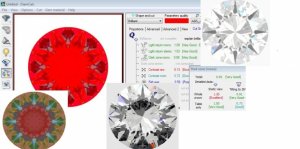
- Joined
- Aug 4, 2008
- Messages
- 15,784
Coming up with a combination that has slightly higher total light return aka brightness than tolk in some light conditions is easy.teobdl|1373420005|3480009 said:2. Why has the Tolk pav crown combination stayed so popular? There is another combination that would perform pretty similarly in overall (at least in fire, brilliance), but is much spreadier:
Pav: 38
Crown: 25
Table: 53
LGF: 78
Star: 55
There are thousands of possible combos if all you care about is total light return.
However just total light return does not make a well performing diamond nor the best of the best.
many lighting conditions, Fire, scintillation, contrast, obstruction, durability, set-ability and yield from rough all have to be taken into account.
When you consider all that, modern tolk and near tolk is very hard to beat.
teobdl|1373420005|3480009 said:Yeah, the link wouldn't work for me either... but it is the correct URL! Just google "GIA fall 2001 fire," and it's right there.
It's a very good article to complement the one from AGS. Thanks, TL!
Both articles got me thinking...
1. It seems as though Tolk's choice of P40.75 C34.5 actually did NOT maximize light return for his presumed LGF and table! Given his LGF of 50-60 and very small table maximum light return would be "steep deep"--in fact, it probably hits exactly where the AVR is cut (a little over 41 pav, a little over 35 crown).
2. Why has the Tolk pav crown combination stayed so popular? There is another combination that would perform pretty similarly in overall (at least in fire, brilliance), but is much spreadier:
Pav: 38
Crown: 25
Table: 53
LGF: 78
Star: 55
I don't know if all those align exactly, but you get the point. The character would be a little different, but I'm sure there's a market for people who want a huge spread and still very good to excellent light performance (at least in theory).
This combination has low Fire, but it would be useful for rough with very high absorption spectrum
http://www.gemology.ru/cut/english/document4_5.htm
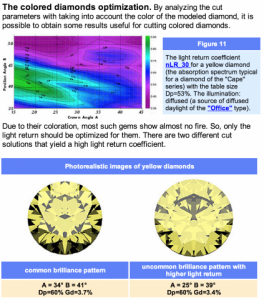
- Joined
- Aug 15, 2000
- Messages
- 19,139
Thank you all for partaking in the poll and the discussion.
I can see that fire is considered to be a very favorable attribute for diamond lovers - those who participate here are definitely among the more knowledgeable diamond lovers. So I have given fire potential an equivalent weighting to brightness or brilliance potential, where as in the earlier iterations of HCA the brilliance factor had twice the weight of fire data.
During the past week or two Paul Slegers and I have had some pleasant off line discussions. From the Pricescope advanced tutorial I think the graphics in the top right corner say it all.
https://www.pricescope.com/wiki/diamonds/diamond-crown-and-pavilion I wrote this at least 12 years ago.
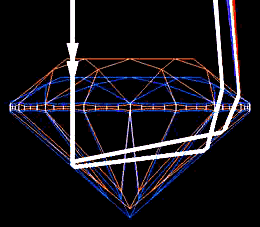
I can see that fire is considered to be a very favorable attribute for diamond lovers - those who participate here are definitely among the more knowledgeable diamond lovers. So I have given fire potential an equivalent weighting to brightness or brilliance potential, where as in the earlier iterations of HCA the brilliance factor had twice the weight of fire data.
During the past week or two Paul Slegers and I have had some pleasant off line discussions. From the Pricescope advanced tutorial I think the graphics in the top right corner say it all.
https://www.pricescope.com/wiki/diamonds/diamond-crown-and-pavilion I wrote this at least 12 years ago.

- Joined
- Sep 2, 2002
- Messages
- 2,859
Dear Garry,
As we discussed already offline, this graphic does not say it all.
The observation of fire is mainly due to 4 factors:
- The light environment,
- The observer,
- The contrast of the diamond,
- The dispersion coming out of the diamond.
The graphic shows a relatively rare example of how a lower pavilion angle combined with a steeper crown angle can increase the last factor, dispersion, in the case of the observer having a flashlight on the tip of his nose.
Just to be clear, nothing wrong with the graphic, it just does not say it all, it says a little bit.
Live long,
As we discussed already offline, this graphic does not say it all.
The observation of fire is mainly due to 4 factors:
- The light environment,
- The observer,
- The contrast of the diamond,
- The dispersion coming out of the diamond.
The graphic shows a relatively rare example of how a lower pavilion angle combined with a steeper crown angle can increase the last factor, dispersion, in the case of the observer having a flashlight on the tip of his nose.
Just to be clear, nothing wrong with the graphic, it just does not say it all, it says a little bit.
Live long,
- Joined
- Aug 4, 2008
- Messages
- 15,784
Interesting discussion.
My opinion from real world and DC observations is that the c/p combination can effect the range of light conditions a diamond shows fire. Garry is right there.
However the lower halves have to match the c/p angle combination for it to work in my opinion.
When you get to the extremes or specialized combos small changes in the lower halves have a much greater effect than in a near tolk in my opinion.
Particularly when pavilion angles get below 40.5 degrees small changes in the lowers can make the difference between a diamond with a nice balance of contrast and one with an overly dark table from obstruction.
So while hca can identify possible combinations that show the effect of showing fire more of the time it is not a sure answer and more investigation/information is needed in my opinion.
My opinion from real world and DC observations is that the c/p combination can effect the range of light conditions a diamond shows fire. Garry is right there.
However the lower halves have to match the c/p angle combination for it to work in my opinion.
When you get to the extremes or specialized combos small changes in the lower halves have a much greater effect than in a near tolk in my opinion.
Particularly when pavilion angles get below 40.5 degrees small changes in the lowers can make the difference between a diamond with a nice balance of contrast and one with an overly dark table from obstruction.
So while hca can identify possible combinations that show the effect of showing fire more of the time it is not a sure answer and more investigation/information is needed in my opinion.
- Joined
- Aug 15, 2000
- Messages
- 19,139
Karl_K|1375111563|3492447 said:Interesting discussion.
My opinion from real world and DC observations is that the c/p combination can effect the range of light conditions a diamond shows fire. Garry is right there.
However the lower halves have to match the c/p angle combination for it to work in my opinion.
When you get to the extremes or specialized combos small changes in the lower halves have a much greater effect than in a near tolk in my opinion.
Particularly when pavilion angles get below 40.5 degrees small changes in the lowers can make the difference between a diamond with a nice balance of contrast and one with an overly dark table from obstruction.
So while hca can identify possible combinations that show the effect of showing fire more of the time it is not a sure answer and more investigation/information is needed in my opinion.
Agreed Karl,
And in a perfect world I would add this as a factor into HCA, but the lab rounding is even worse.
Lower girdles are also affected by table size.
An old article on http://ideal-scope.com/3.manuf_fine_tuning.asp
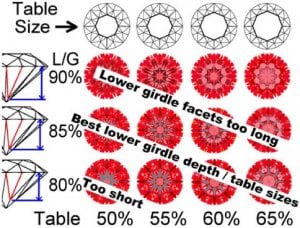
- Joined
- Oct 21, 2004
- Messages
- 5,096
Fun reading this thread (brings me back a few yearsGarry H (Cut Nut)|1375143729|3492786 said:Karl_K|1375111563|3492447 said:Interesting discussion.
My opinion from real world and DC observations is that the c/p combination can effect the range of light conditions a diamond shows fire. Garry is right there.
However the lower halves have to match the c/p angle combination for it to work in my opinion.
When you get to the extremes or specialized combos small changes in the lower halves have a much greater effect than in a near tolk in my opinion.
Particularly when pavilion angles get below 40.5 degrees small changes in the lowers can make the difference between a diamond with a nice balance of contrast and one with an overly dark table from obstruction.
So while hca can identify possible combinations that show the effect of showing fire more of the time it is not a sure answer and more investigation/information is needed in my opinion.
Agreed Karl,
And in a perfect world I would add this as a factor into HCA, but the lab rounding is even worse.
Lower girdles are also affected by table size.
An old article on http://ideal-scope.com/3.manuf_fine_tuning.asp
Surely I agree with you both but since Garry mentioned old/chunky/retro-cuts including cushions then based on my few years of R&D on the subject, minor facets are influenced by azimuth calculations..., even more so than the mains especially when taking shallower pavilions / steeper crowns into consideration. Garry, LGF lengths are only half of the story.
- Joined
- Sep 2, 2002
- Messages
- 2,859
The HCA uses a best-case-scenario, within the parameters entered. This is the main reason why it is a rejection-tool on potential brightness.
Seeing thousands of certified stones (various labs) per week from a multitude of cutting-houses, I can say that one very rarely encounters such a best-case-scenario, aside from extemely often the combo of average main angles already being less attractive.
Live long,
Seeing thousands of certified stones (various labs) per week from a multitude of cutting-houses, I can say that one very rarely encounters such a best-case-scenario, aside from extemely often the combo of average main angles already being less attractive.
Live long,
- Joined
- Aug 15, 2000
- Messages
- 19,139
- Joined
- Oct 21, 2004
- Messages
- 5,096
If I understand your question correctly, I witnessed mostly LGF's on rounds in the 80% length area.Garry H (Cut Nut)|1375224834|3493318 said:What do you all think are the most commonly encountered LG's and star facet %'s? Means or medians I guess.
What are the extremes at say the stats outlyers that encompass 80% of what you see?
I also believe most cutting houses dont take VF size (and shapes) that much into consideration. (e.g. play it safe.)
Share:
The Ultimate Guide to Men’s Wedding Bands: Metals, Fit & Finish
The Ultimate Guide to Men’s Wedding Bands: Metals, Fit & Finish - 06/27
Chipped Diamonds: Causes, Risks, and What You Should Do About It
Chipped Diamonds: Causes, Risks, and What You Should Do About It - 06/27


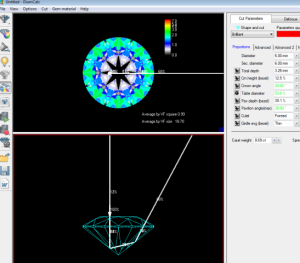
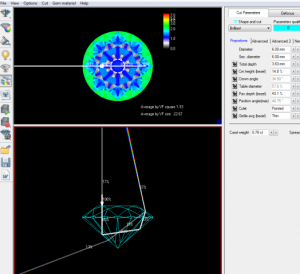
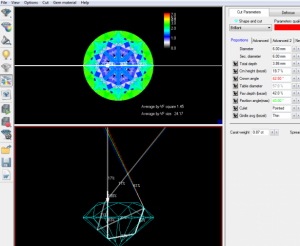


300x240.png)